Fracastorius is a genus of Asian seed bugs in the tribe Homoeocerini, erected by William Lucas Distant in 1901. It contains the single species Fracastorius cornutus which was originally recorded from Myanmar.
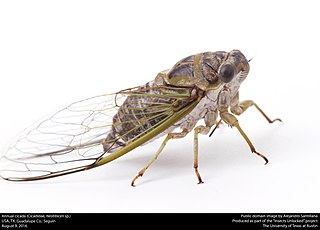
Cicadidae, the true cicadas, is one of two families of cicadas, containing almost all living cicada species with more than 3,200 species worldwide.

Baron Dufferin and Claneboye, of Ballyleidy and Killyleagh in County Down, Northern Ireland, is a title in the Peerage of Ireland. It was created on 30 July 1800 for Dame Dorcas Blackwood, widow of Sir John Blackwood, 2nd Baronet, Member of the Irish Parliament for Killyleagh and Bangor, in return for support for the Union of Ireland and the United Kingdom.
Aurelianus is a genus of seed bugs in the tribe Mictini, erected by William Lucas Distant in 1902. It includes the species Aurelianus elongatus.
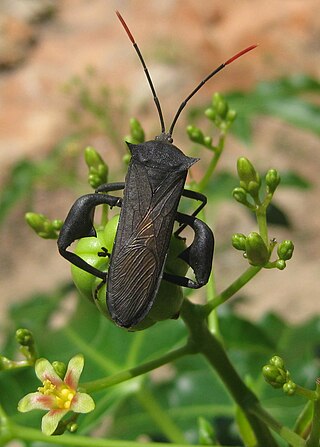
Coreidae is a large family of predominantly sap-sucking insects in the Hemipteran suborder Heteroptera. The name "Coreidae" derives from the genus Coreus, which derives from the Ancient Greek κόρις (kóris) meaning bedbug.

Pentatominae is a subfamily of Pentatomidae, a family of shield bugs. This subfamily is the largest one within the Pentatomidae, having 4937 species classified in 938 genera. Species in this subfamily are phytophages and several of them are considered agricultural pests. Some invasive pentatomines such as Halyomorpha halys and Bagrada hilaris have been considered household pests. Higher systematics of the group have been revised by Rider et al.

The Tettigarctidae, known as the hairy cicadas, are a small relict family of primitive cicadas. Along with more than 20 extinct genera, Tettigarctidae contains a single extant genus, Tettigarcta, with two extant species, one from southern Australia and one from the island of Tasmania. Numerous fossil species have been described from the Late Triassic onwards. Tettigarcta are the closest living relatives of the true cicadas.

William Lucas Distant was an English entomologist.

Heliothis is a genus of moths in the family Noctuidae. It was first described by Ferdinand Ochsenheimer in 1816. Some of the species have larvae which are agricultural pests on crop species such as tobacco, cotton, soybean and pigeon pea. Some species originally in this genus have been moved to other genera, see Chloridea and Helicoverpa.
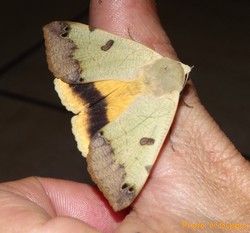
Ophiusa is a genus of moths in the family Erebidae erected by Ferdinand Ochsenheimer in 1816.

Plecoptera is a genus of moths of the family Erebidae. It was described by Achille Guenée in 1852.

Nosodendridae is a family of beetles, with less than a hundred species in three extant genera, which are found worldwide. Nosodendron, the largest genus, is found in forests and attracted to yeast generated slime on the wounds of trees, and likely consumes fermented substances as well as fungi and microorganisms. Several additional genera and species are known from the fossil record. Nosodendridae is considered to be an isolated lineage within Polyphaga, being the sister group to the clade containing Staphyliniformia, Bostrichoidea and Cucujiformia.
The Tavoyan or Dawei dialect of Burmese (ထားဝယ်စကား) is spoken in Dawei (Tavoy), in the coastal Tanintharyi Region of southern Myanmar (Burma).

Limnichidae, commonly called minute marsh-loving beetles, is a family of beetles belonging to Byrrhoidea. There are at least 30 genera and 350 described species in Limnichidae. They are found worldwide, with the greatest diversity in tropical regions. Most species seem to be associated with water-adjacent habitats, such as riparian and coastal locations, though many species are likely fully terrestrial, with some species being associated with leaf litter and arboreal habitats. Species with known diets feed on moss or algae. The oldest fossils of the family are known from mid-Cretaceous Burmese amber from Myanmar.

Leptopodidae is a family of spiny-legged bugs in the order Hemiptera. There are about 15 genera and more than 40 described species in Leptopodidae.

Mogaung Monastery is a Buddhist monastery in Mandalay, Myanmar (Burma). The wooden monastery was built by the Mogaung Mibaya, a minor queen of King Pagan Min in 1847. The monastery's dimensions are 258 by 106 feet and is supported by 342 teak pillars. The monastery's wooden carvings are adorned with motifs from the Ramayana.
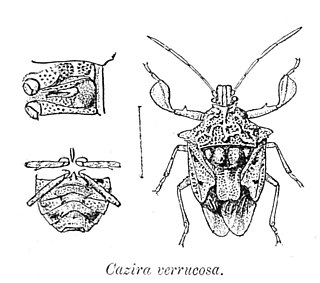
Cazira is a genus of shield bugs found in the Indo-Malayan region.
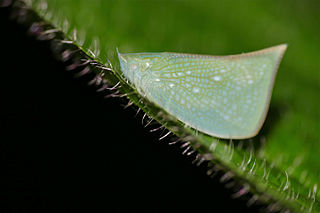
Lawana is a genus of planthoppers in the family Flatidae, erected by William Lucas Distant in 1906. In 1923, Leopold Melichar confirmed placement of this genus in tribe Flatini and subtribe Lawanina. Species are recorded from tropical Africa and Asia.
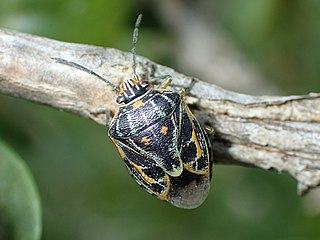
The Antestiini are a tribe of shield-bugs, in the subfamily Pentatominae erected by William Lucas Distant in 1902. Genera are distributed from Africa to South-East Asia and Australia; in West Africa genera such as Antestiopsis are significant coffee pests.















